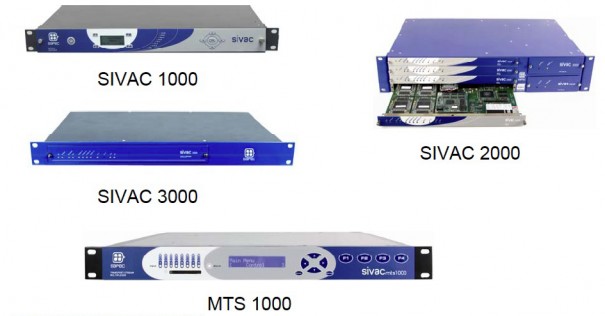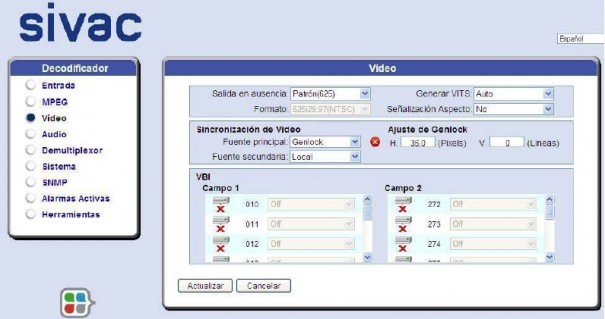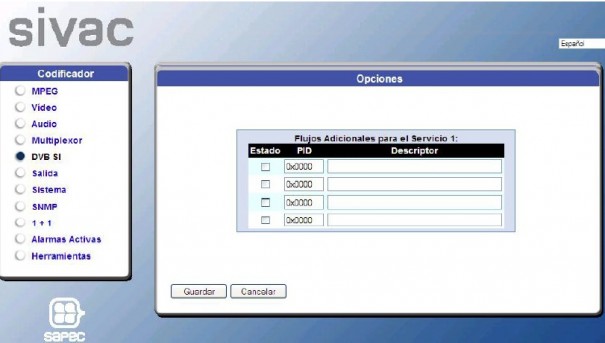Sapec will demonstrate the improvements in its Sivac line at NAB
La familia de codificadores y multiplexores Sivac de Sapec ofrecen ahora mejoras como la inclusión de sincronismo externo en decodificadores y adición de audios a un servicio existente en multiplexores.
Sapec, coincidiendo con NAB 2011, presentará algunas mejoras en los modelos de multiplexores y codificadores y decodificadores MPEG-2 en definición estándar (SD) de la familia Sivac.
Los nuevos modelos permiten escoger el sincronismo de una de las tres siguientes fuentes: recuperado (PCR que es transmitido por el Transport Stream), local (referencia interna en el decodificador) y genlock (señal externa de sincronismo). En este último caso caso es posible ajustar la señal horizontalmente -píxeles- o verticalmente -líneas-. Si falla la señal de sincronismo el decodificador escogerá una de las otras fuentes que haya sido configurada como secundaria (recuperado o local).
Otra novedad en el decodificador Sivac es la gestión de las líneas de test (VITS) en la salida de vídeo, mediante dos modos de funcionamiento: “Auto” (el decodificador SIVAC inserta líneas de test si la señal de entrada no las incluye. En caso de que las tuviera, las deja pasar) y “No” (el decodificador no inserta líneas de test si la señal de entrada no las incluye. En caso de que las tuviera, las deja pasar).
Gestión en relación de aspecto
Se ha mejorado la gestión de la relación de aspecto tanto en los codificadores como en los decodificadores SIVAC. En los codificadores Sivac se puede señalizar la relación de aspecto de la señal de video siguiendo las normas Wide Screen Signaling (WSS) o Active Format Description (AFD) tanto en las versiones VI (Vertical Interval) como SS (Screen Signaling) o bien forzarla directamente a 4:3 o 16:9. Por su parte, en los decodificadores SIVAC se puede recodificar la información de la relación de aspecto de la señal de entrada al formato AFD, WSS o ambas o bien dejarla pasar en el mismo formato de entrada.
Sapec también ha perfeccionado la característica de qué salida mostrar en caso de que no haya señal de entrada en el decodificador Sivac. Ahora es posible seleccionar: “No video” (ausencia de señal), salida en negro (tanto en 525 como 625 líneas) o salida de un patrón de franjas verticales (tanto en 525 como 625 líneas).
En los codificadores Sivac, se ha incorporado la posibilidad de generar la señalización de hasta cuatro servicios adicionales (subtítulos, RDS, datos privados…) a los generados por el propio codificador, añadiendo el PID y el descriptor para cada una de las cuatro PMT’s que es capaz de generar el codificador. Así, es posible crear un servicio de vídeo con audio y hasta tres servicios adicionales de audio (radios) señalizados separadamente, característica que se ha utilizado ampliamente en las cabeceras de televisión digital terrestre (TDT).
Multiplexores MTS
Por otra parte, los multiplexores MTS de la familia SIVAC ofrecen la posibilidad de embeber servicios de audio dentro de otro servicio, de manera que, por ejemplo, sería posible añadir idiomas adicionales a un servicio ya existente de televisión con audios.
También es posible analizar el bitrate de cada una de las entradas individualmente y establecer alarmas sobre él (picos de entrada, ausencia de señal) de manera que es posible monitorizar incidencias en el flujo de entrada.
En el modelo MTS-1400, se ha incrementado la funcionalidad de salidas virtuales, pasado de 4 a 8, de manera que es posible establecer hasta 8 configuraciones de salida distintas en función de las condiciones de alarma o error que se produzcan en la entrada.
Los equipos SIVAC, de consolidada presencia en el mercado, son codificadores y decodificadores MPEG-2 SD diseñados y fabricados por SAPEC para aplicaciones de contribución y distribución de señales de televisión que se presentan en tres formatos: SIVAC 1000 (unidades de 1RU con panel frontal de configuración), SIVAC 2000 (unidades modulares de 2RU con capacidad de hasta 4 tarjetas codificadores/decodificadoras) y SIVAC 3000 (unidades 1RU sin panel frontal de configuración).
Los multiplexores MTS-1000 y MTS-1400 de la familia SIVAC son equipos capaces de combinar hasta 8 entradas de Transport Stream (MPTS o SPTS) y proporciona las herramientas necesarias para la formación y manipulación del stream de salida, incluyendo la manipulación de cada PID de forma independiente. Soportan los estándares MPEG, DVD y ATSC. El modelo MTS-1400 soporta además conmutación en la configuración de la salida en caso de error o fallo a la entrada.
Did you like this article?
Subscribe to our NEWSLETTER and you won't miss anything.





